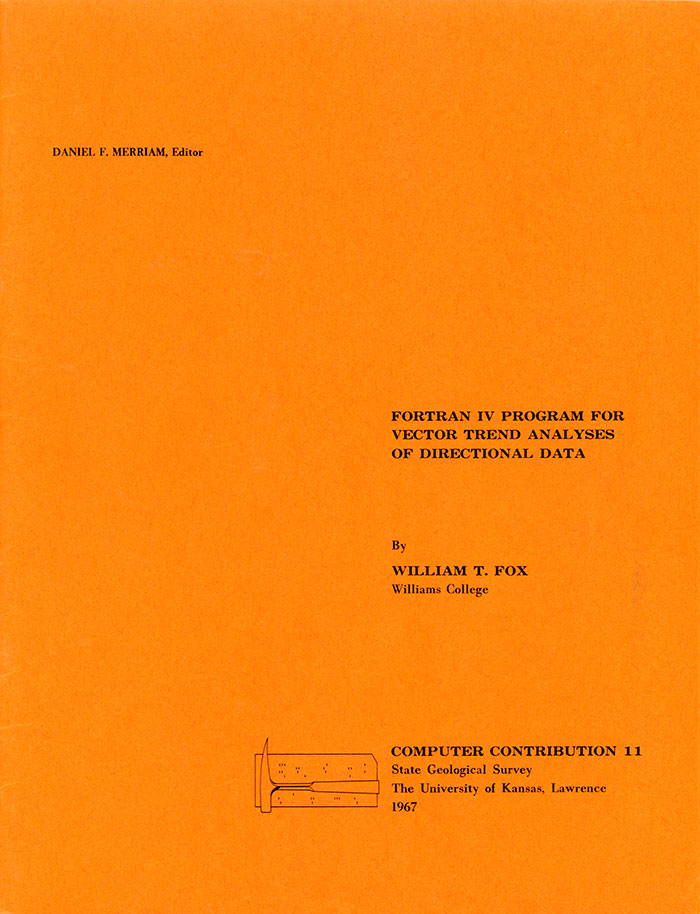
Kansas Geological Survey, Computer Contributions 11, originally published in 1967
Williams College

Originally published in 1967 as Kansas Geological Survey Computer Contributions 11.
A FORTRAN IV computer program for the IBM 7090/7094 uses orthogonal polynomial trend-surface mapping techniques in the analysis of regional trends in directional data. Direction cosines are used for each cell in the grid to compute the vector mean azimuth, mean dip angle, length of resultant vector, and spherical radius of the circle of confidence around the resultant vector. Linear, quadratic, cubic, quartic, and quintic orthogonal polynomial response surfaces are computed and plotted as isoazimuth and vector trend maps to aid in interpreting regional flow patterns. Residuals from the trend-surface maps emphasize local topographic anomalies on the depositional surface.
The first example output consists of 20 azimuth and dip measurements of cross-bedding from the Wasatch Formation of Wyoming. A second example is based on a study of the orientation of drumlins south of Lake Ontario in New York State. The third example uses cross-bedding measurements from the Pocono Formation in Pennsylvania. In the last two examples, linear, quadratic, and cubic isoazimuth and vector trend maps are used to interpret the major current pattern, and residual maps to outline topographic highs or lows.
As a wave breaks over an offshore bar or a glacier molds boulder clay into a drumlin, current direction is recorded. By plotting a large number of recorded directions as vectors with a constant magnitude, where the magnitude has no geologic significance, it is possible to study the distribution of currents which existed when for example a sediment was deposited. Because major currents move down a regional slope under the influence of gravity or are carried parallel to a shoreline by longshore drift, a study of the trends of ancient currents provides a means of paleogeographic interpretation. In this computer program, techniques developed for orthogonal polynomial trend-surface mapping of gridded data are applied to directional data, and the method is called vector trend analysis.
Vector trend analysis makes use of techniques explained by Grant (1957) for fitting a trend surface using orthogonal polynomials. The program is limited to gridded data but can be expanded to accept nongridded data through the use of nonorthogonals as described by Krumbein (1959). To handle vectorial data, direction cosines are used for the computation of the resultant vector within each cell. Steinmetz (1962) discusses the use of direction cosines for the analysis of dip directions and dip angles in crossbedding. Direction cosines are used for three-dimensional vector summation to determine both direction of the dip and dip angle. Magnitude of the resultant vector, R, is computed for each grid location along with the spherical radius of the circle of confidence, theta, around the resultant vector. The spherical radius of the circle of confidence gives a measure of dispersion of observed vectors around the resultant vector.
In vector trend analysis, the linear, quadratic, or cubic trend surfaces can be used to represent trends of regional flow pattern, and residuals to show local anomalies or deflections from the regional trend. Vector trend maps show the overall flow pattern that is parallel to the paleoslope, and residuals are used to interpret local topographic highs or lows which would deflect the major flow pattern.
The total sum of squares of deviation from the mean azimuth is computed for the resultant vector map. For each trend surface, the sum of squares of deviations from the trend is computed. Reduction in the percentage of the total sum of squares indicates the amount of total variability accounted for by the trend.
The author thanks several people for assistance in different phases of the development of this program. Dr. L. Nobles and Dr. W. C. Krumbein at Northwestern University introduced the author to the use of trend-surface analysis for studying directional data. Robert Elwell of Williams College collected and analyzed data for the drumlin example using a desk calculator. The Massachusetts Institute of Technology and Stanford University kindly allowed use of their computer facilities. Dr. J. W. Harbaugh of Stanford University read the manuscript and made several useful suggestions.
Read the PDF version (7.5 MB)
Kansas Geological Survey
Placed on web Aug. 23, 2019; originally published 1967.
Comments to webadmin@kgs.ku.edu
The URL for this page is http://www.kgs.ku.edu/Publications/Bulletins/CC/11/index.html